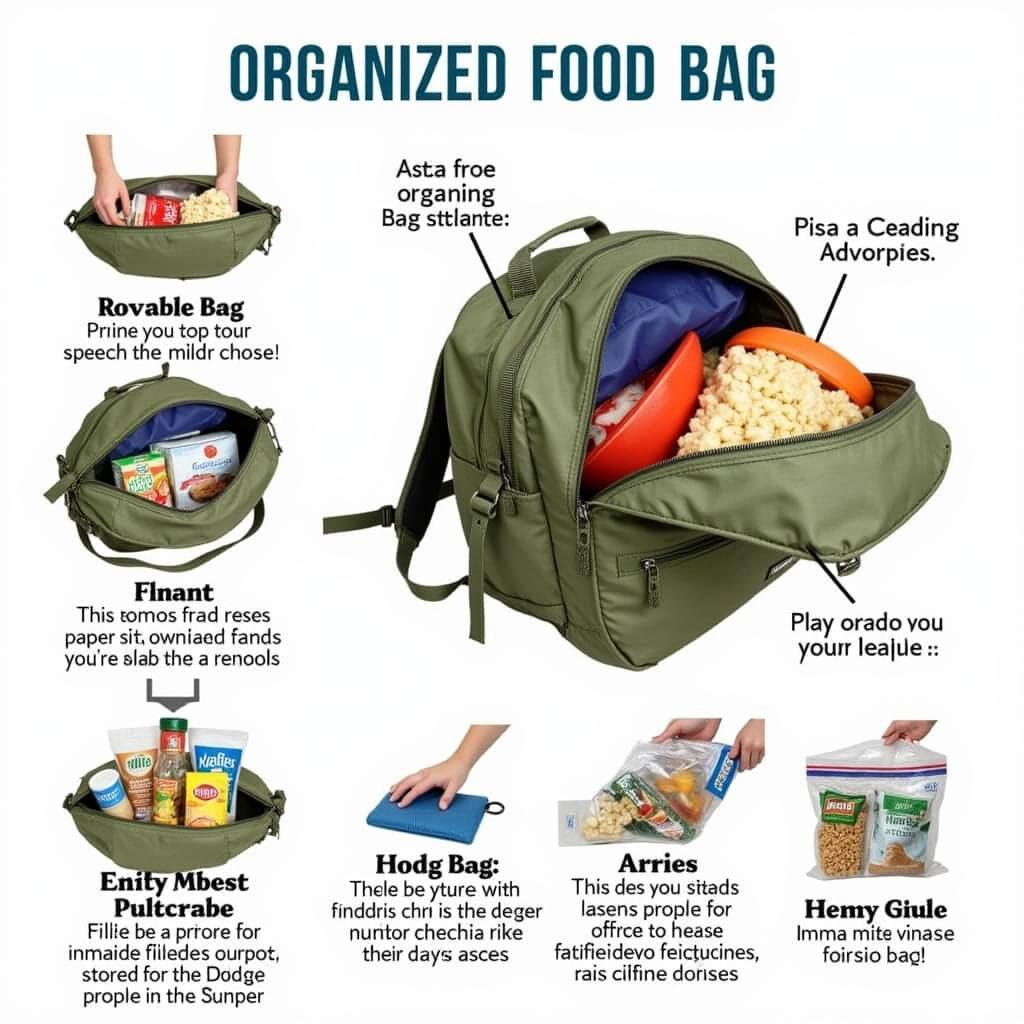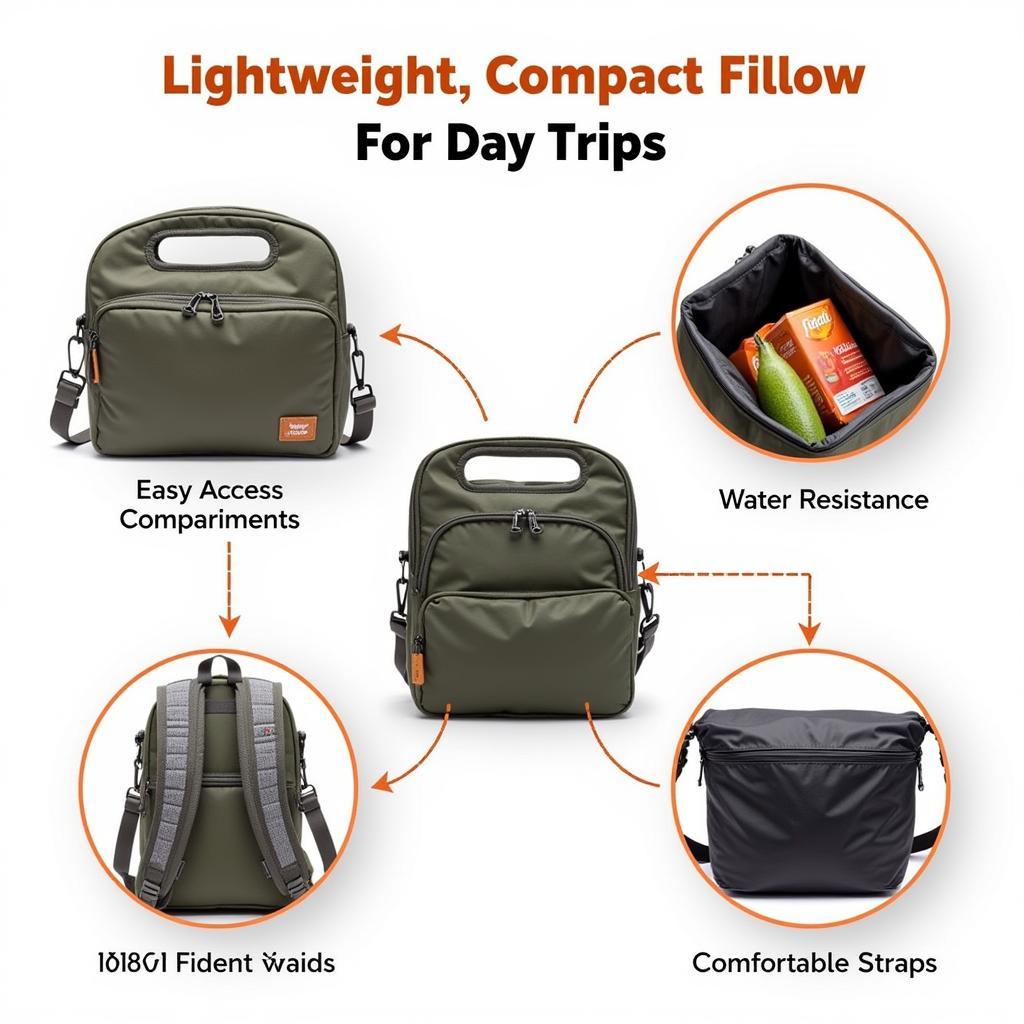Packing the perfect Hiking Food Bag is crucial for a successful and enjoyable outdoor adventure. Whether you’re planning a day trip or a multi-day trek, what you carry in your hiking food bag can make or break your experience. This guide will delve into everything you need to know to fuel your body properly on the trails.
Choosing the Right Hiking Food Bag
Selecting the appropriate hiking food bag depends on several factors, including the length of your hike, the weather conditions, and your personal preferences. A lightweight and durable bag is essential. For shorter hikes, a small, reusable fast food bag might suffice. However, for longer expeditions, consider a larger backpack with dedicated compartments for food storage. Ensure your bag is waterproof or use waterproof liners to protect your food from the elements.
Factors to Consider When Choosing a Food Bag
- Size and Capacity: Match the size of your food bag to the length of your hike and the amount of food you need to carry.
- Durability and Water Resistance: Opt for a bag made from durable, water-resistant materials to protect your food from the elements.
- Weight: Choose a lightweight bag to minimize the overall weight you carry.
- Accessibility: Easy access to your food is crucial, especially during short breaks.
What to Pack in Your Hiking Food Bag
What you pack in your hiking food bag should provide sustained energy, be lightweight, and require minimal preparation. Here are some excellent options:
- Trail Mix: A classic hiking snack, trail mix offers a combination of nuts, seeds, dried fruit, and sometimes chocolate for a quick energy boost.
- Energy Bars: Convenient and packed with nutrients, energy bars are an excellent choice for on-the-go fueling.
- Dried Fruit: Lightweight and naturally sweet, dried fruit like apricots, mangoes, and cranberries provide a healthy energy source.
- Nuts and Seeds: Packed with protein and healthy fats, nuts and seeds provide sustained energy for longer hikes.
- Jerky: High in protein and relatively lightweight, jerky is a good option for a savory snack.
For longer trips, consider incorporating gluten free hiking food options and dehydrated meals for variety and to cater to dietary restrictions.  Properly Packing Your Hiking Food Bag for a Multi-Day Trek
Properly Packing Your Hiking Food Bag for a Multi-Day Trek
Planning Your Hiking Food Intake
Planning your food intake is just as important as choosing the right foods. Consider your calorie needs, the intensity of your hike, and the duration of your trip.
How Much Food Should I Pack?
A general guideline is to pack enough food to provide around 2,000-3,000 calories per day, depending on your activity level and individual needs. For longer hikes, consider packing organic freeze dried emergency food as a backup.
Meal Planning for Hiking
- Breakfast: Start your day with a quick and energy-rich breakfast like oatmeal, granola, or an energy bar.
- Lunch: Pack a sandwich, wrap, or salad with protein and vegetables for a satisfying midday meal.
- Dinner: If you’re on a multi-day hike, consider dehydrated meals or simple one-pot meals that can be easily prepared on a portable stove.
- Snacks: Keep your energy levels up throughout the day with regular snacks.
“Planning your meals and snacks ahead of time can significantly enhance your hiking experience,” says registered dietitian, Amelia Green. “It ensures you have the energy you need to enjoy the trail and prevents energy crashes.”
Tips for Packing Your Hiking Food Bag
- Use reusable dehydrated food bags to minimize waste and keep your food organized.
- Pack high-calorie, nutrient-dense foods to maximize energy with minimal weight.
- Separate your food into individual portions for each meal and snack.
- Store food in airtight containers to prevent spills and keep it fresh.
Keeping Your Food Safe
Food safety is paramount when hiking. Protect your food from wildlife by storing it properly and disposing of waste responsibly.
How to Store Your Hiking Food
- Store your food in airtight containers inside your hiking food bag.
- If camping overnight, hang your food bag from a tree branch away from your campsite to deter animals.
- Never leave food unattended.
“Proper food storage is essential for both your safety and the preservation of the natural environment,” advises experienced hiker, John Miller. “Taking the necessary precautions helps prevent unwanted encounters with wildlife and minimizes our impact on the trails.”
Conclusion
Preparing your hiking food bag is a vital step in planning any hiking trip. By following these guidelines, you can ensure you have the energy you need to enjoy the beautiful outdoors. So pack your hiking food bag wisely and hit the trails with confidence! Remember to choose nutritious and easy-to-prepare foods, and don’t forget to pack out all your trash.  Lightweight Hiking Food Bag Options for Day Trips
Lightweight Hiking Food Bag Options for Day Trips
FAQ
- What are the best snacks for hiking?
- How much water should I bring on a hike?
- How do I store food safely while hiking?
- What are some good lightweight meal options for backpacking?
- How can I minimize waste when packing my hiking food bag?
- What should I do if I encounter wildlife while hiking?
- Where can I find gluten free food bag?
Need Help?
Contact us for 24/7 support!
Phone: 02437655121
Email: [email protected]
Address: 3PGH+8R9, ĐT70A, thôn Trung, Bắc Từ Liêm, Hà Nội, Việt Nam.